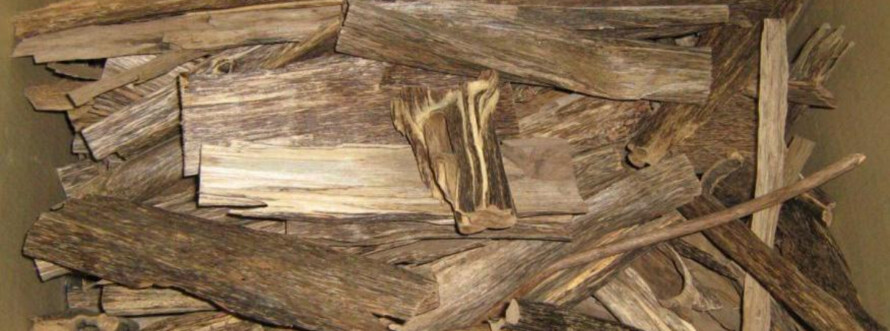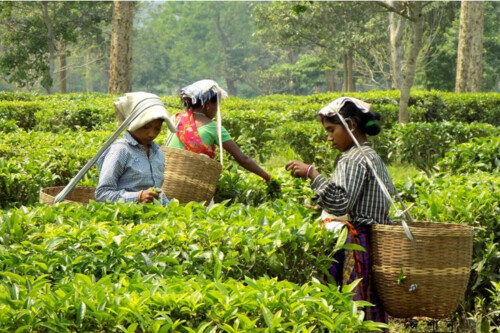Assam's tea growers are battling many challenges - high production costs, low profit margin, labour problems, and of late, coal shortage. Amid all this, they have found a window of opportunity, the critically endangered agarwood tree, that promises a symbiotic relationship in which they can both benefit from each other.
Agarwood (Aquilaria malaccensis) is native to the state and other parts of northeast India. Although its use is varied - as an aromatic, as medicine, and for religious purposes - Xasi, as it is called in Assamese, is most famed for the expensive perfumes that it is used for making. Such is its exclusivity and such is the demand, particularly in the Arab countries, that it is often termed as "liquid gold". There is, however, a catch. It is only an infected agarwood tree that produces the dark resin that makes the aromatic oil. It is only when the Aquilaria tree is physically injured, either by fungal infection or by the borer insect called Neurozerra conferta (Zeuzera conferta) that it produces the dark resin as a defence mechanism.
Indiscriminate felling of the mature tree for agarwood trade has led to its mass depletion, so much so that it has been declared critically endangered by International Union for Conservation of Nature. The Assam government, in an effort to salvage this native tree from further disappearance, notified the Assam Agarwood Promotion Policy 2020, offering incentives to farmers and others including the tea industry to raise agarwood plantations.
 Agarwood, native to Assam and other parts of northeast India, is critically endangered.
Agarwood, native to Assam and other parts of northeast India, is critically endangered.
Photo by Hafizmuar/Wikimedia Commons.
Tea growers look elsewhere for profits
For many small tea growers, however, such multi-cropping began even before this formal notification. Imtaz Ali of Namti Chariali in the Sibsagar district, for instance, first planted agarwood saplings in his tea garden almost 10 years ago. Like many other small tea growers, Ali said that this was to supplement his income. "Tea is not as profitable a business today as it was 10-20 years back," Ali said, "Agarwood trees, on the other hand, can be very profitable. Depending on the girth of a matured and infected tree, one can earn almost Rs. 8 lakhs from it."
Talking about the issues that small tea growers like him have been facing, Ali said that ever since there has been a spurt in bought-leaf factories in his vicinity, tea growers have been facing losses. Bought-leaf factories are units that buy leaves from tea gardens not owned by them and convert them to processed tea. Small tea growers mostly rely on these units for their business. "If I refuse to sell my tea at a lower price, they would compromise on the quality and go for someone else," says Ali.
In June this year, the price of raw tea leaves in these units went down from around Rs. 40 to almost Rs. 20 per kg. It led to an uproar and a minimum fixed rate was thereafter decided upon, with quality being a yardstick. Despite this, tea growers are sceptical about the future and have decided that the ‘perfume tree' could be a sustainable alternative.
"I have planted agarwood trees as a 10×10 hedge around my one hectare tea garden," said Ali. "Growing these trees don't need any investment. No manure, no irrigation. They grow on their own, and the best part is that the moth that infects this tree is found naturally in this region." Four districts, of which Sibsagar, Jorhat, and Golaghat are in upper Assam, along the northern bank of the Brahmaputra, while Hojai is in lower Assam, account for 91 per cent of the state's agarwood trees. Zeuzera conferta, the borer that infects the agarwood tree, is also found more commonly in upper Assam.

Photo: With profits from tea dropping, growers are opting for multicropping. Credit: Wikimedia Commons.
Like Ali, Joon Das, also a tea grower in the Dibrugarh district, has planted agarwood saplings in his tea garden and is now awaiting their maturity. "I don't have the expertise to distill the resin and extract the oil. I will sell the wood once it is infected by the borer to traders in Hojai," he said. Agarwood tree saplings are also being planted by bigger tea companies like Goodricke Group in some of their gardens, as a pilot project. Abrar Haque Chowdhury, the company's General Manager (operations) in Assam said that planting agarwood in their tea gardens is a means of diversification, for additional revenue, in view of rising production costs and falling profit margins in their business.
Sessa tea estate in the Dibrugarh district is among those of the tea companies that have started agarwood plantation after the Assam government gazette notification. Monirul Islam, manager of Sessa, said that the saplings have been planted in land that is not used for tea plantation. "Planting these trees in between the tea bushes doesn't make sense because they are not canopy trees that would be able to provide shade," he said. It would however take a minimum of five to ten years for turnover from these trees.
A double-edged sword?
While agarwood has offered hope to the tea industry in Assam - and in return reverse its critically endangered status - Purabi Saikia of the Central University of Jharkhand is sceptical about inter-cropping one with the other. Saikia, who has done a study on growing agarwood in homestead gardens in Assam, said that if planted together it could potentially harm tea plantations in the long run. "Agarwood is not a legume; it extracts nutrition from the soil to grow. So if it's planted with tea bushes, it will compromise the health of the tea plants," she said.
Saikia's opinion is supported by evidence from the field. Imtaz Ali, for instance, has noticed that those tea plants that are nearer the agar trees produce 100 grams less leaves than those farther away. "We typically get 250 grams of tea leaves from a plant, but those near the agar trees produce less," he said, "So yes, it has affected productivity." Despite this, he is not willing to let go of the agar trees. "Right now the agar trees have more potential of giving me a better profit margin."
 |
A rich source of revenue
Monirul Islam, who is also from Namti Chariali, added that so rich are the tree's properties that the even its chips are sold at a high price to make incense sticks. Boya oil gel, extracted from non-infected trees, is used in cosmetics, Ayurvedic medicine, as well as in cooking. Comparing the average revenue one can earn from tea versus agarwood plantation, Jehirul Islam, who holds a patent for artificial infection of agarwood trees, said, "One can earn between Rs. 27-28 lakhs from one hectare of tea plantation; but Rs. 2-3 crores from agarwood plantation." He played a key role in the state cabinet's decision to accord industrial status to agarwood-related activities and said that the state has the potential to earn an "annual turnover of Rs. 50,000 crores" from it. "I want to turn agarwood-related activities into a cottage industry," he added.
The state government, in its notification which came into effect this January, has said that farmers would be provided an incentive of Rs. 1 lakh for planting 3000 agarwood saplings along the boundary of their fields or tea gardens. Saplings will also be provided to small tea growers free of cost. Merging the tea industry with agarwood plantation, it added, will open "new vistas for plantation-based economy of the state." But whether intertwining the two will actually change their fate is to be seen.























